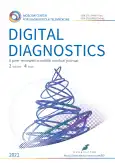Encapsulated necrotic pancreatitis
- Authors: Kitavina S.I.1, Petrovichev V.S.1, Ermakov A.N.2, Ermakov N.A.1, Nikitin I.G.1
-
Affiliations:
- Therapy and Rehabilitation Center
- Moscow State University of Medicine and Dentistry named after A.I. Evdokimov
- Issue: Vol 2, No 4 (2021)
- Pages: 471-480
- Section: Case reports
- URL: https://journals.rcsi.science/DD/article/view/71156
- DOI: https://doi.org/10.17816/DD71156
- ID: 71156
Cite item
Abstract
This study presents a rare clinical case of encapsulated necrotic pancreatitis, which was a complication of acute pancreatitis that arose against the background of alimentary disorders. The aspects of the semiotics of radiation diagnostic methods in the follow-up control of these pathologies were presented.
This case is notable for the manifestation of diseases upon hospital admission, as in the classical edematous form of acute pancreatitis, with a further increase in negative dynamics. This demonstrated the possible stepwise disease development, accompanied by a series of follow-up computed tomography between the clinical and morphological phases of acute pancreatitis and before the formation of pancreatic necrosis, which was complicated by sequestration of the pancreatic body with peripancreatic abscess formation. Afterward, the therapeutic paradigm was changed, and the place of the conservative approach was taken by active surgical tactics, followed by repeated manipulations and follow-up computed tomography and magnetic resonance until the improvement of the patient’s condition.
Full Text
##article.viewOnOriginalSite##About the authors
Svetlana I. Kitavina
Therapy and Rehabilitation Center
Email: skitavina@yandex.ru
ORCID iD: 0000-0002-1280-1089
SPIN-code: 9741-1675
MD, Cand. Sci. (Med.)
Russian Federation, 3 Ivan’kovskoe shosse, 125367, MoscowVictor S. Petrovichev
Therapy and Rehabilitation Center
Email: petrovi4ev@gmail.com
ORCID iD: 0000-0002-8391-2771
SPIN-code: 7730-7420
MD, Cand. Sci. (Med.)
Russian Federation, 3 Ivan’kovskoe shosse, 125367, MoscowAleksandr N. Ermakov
Moscow State University of Medicine and Dentistry named after A.I. Evdokimov
Email: alx-ermakovv@yandex.ru
ORCID iD: 0000-0003-0675-8624
SPIN-code: 9257-9319
MD
Russian Federation, 3 Ivan’kovskoe shosse, 125367, MoscowNikolay A. Ermakov
Therapy and Rehabilitation Center
Email: n-ermakov@yandex.ru
ORCID iD: 0000-0002-1271-7960
SPIN-code: 5985-9032
MD, Cand. Sci. (Med.)
Russian Federation, 3 Ivan’kovskoe shosse, 125367, MoscowIgor G. Nikitin
Therapy and Rehabilitation Center
Author for correspondence.
Email: igor.nikitin.64@mail.ru
ORCID iD: 0000-0003-1699-0881
SPIN-code: 3595-1990
MD, Dr. Sci. (Med.), Professor
Russian Federation, 3 Ivan’kovskoe shosse, 125367, MoscowReferences
- Volkov V, Chesnokova N. Acute necrotizing pancreatitis: Actual questions of classification, diagnosis and treatment of local and widespread purulent-necrotic processes. Bulletin Chuvash University. 2014;(2):211–217. (In Russ).
- Bagnenko SF, Gol’tsov VR. Acute pancreatitis: current state of the problem and unresolved issues. Almanac A.V. Vishnevsky Ins Sur. 2008;3(3):104–112. (In Russ).
- Banks PA, Bollen TL, Dervenis C, et al. Classification of acute pancreatitis-2012: revision of the Atlanta classification and definitions by international consensus. Gut. 2013;62(1):102–111. doi: 10.1136/gutjnl-2012-302779
- Petrov MS, Shanbhag S, Chakraborty M, et al. Organ failure and infection of pancreatic necrosis as determinants of mortality in patients with acute pancreatitis. Gastroenterology. 2010;139(3):813–820. doi: 10.1053/j.gastro.2010.06.010
- Acute pancreatitis. Clinical recommendations of the Ministry of Health of the Russian Federation. Moscow, 2015. (In Russ). Available from: http://общество-хирургов.рф/upload/acute_pancreatitis_2016.doc. Accessed: 15.10.2021.
- Podoluzhny VI, Aminov IH, Rodionov IA. Acute pancreatitis. Kemerovo: POLIGRAF; 2017. 136 р. (In Russ).
- Bagnenko SF, Savello VE, Goltsov VR. Radiation diagnosis of pancreatic diseases: acute pancreatitis. In: Radiation diagnostics and therapy in gastroenterology: national guidelines. Ed. by G.G. Karmazanovsky Moscow: GEOTAR-Media; 2014. P. 349–365. (In Russ).
- Branco JC, Cardoso MF, Lourenço LC, et al. A rare cause of abdominal pain in a patient with acute necrotizing pancreatitis. GE Port J Gastroenterol. 2018;25(5):253–257. doi: 10.1159/000484939
- Zhang H, Chen G, Xiao L, et al. Ultrasonic/CT image fusion guidance facilitating percutaneous catheter drainage in treatment of acute pancreatitis complicated with infected walled-off necrosis. Pancreatology. 2018;18(6):635–641. doi: 10.1016/j.pan.2018.06.004
- Sahu B, Abbey P, Anand R, et al. Severity assessment of acute pancreatitis using CT severity index and modified CT severity index: Correlation with clinical outcomes and severity grading as per the Revised Atlanta Classification. Indian J Radiol Imaging. 2017;27(2):152. doi: 10.4103/ijri.IJRI_300_16
- Shahzad N, Khan MR, Inam Pal KM, et al. Role of early contrast enhanced CT scan in severity prediction of acute pancreatitis. J Pak Med Assoc. 2017;67(6):923–925.
- Avanesov M, Löser A, Smagarynska A, et al. Clinico-radiological comparison and short-term prognosis of single acute pancreatitis and recurrent acute pancreatitis including pancreatic volumetry. PLoS ONE. 2018;13(10):e0206062. doi: 10.1371/journal.pone.0206062
- Smeets XJ, Litjens G, da Costa DW, et al. The association between portal system vein diameters and outcomes in acute pancreatitis. Pancreatology. 2018;18(5):494–499. doi: 10.1016/j.pan.2018.05.007
- Van Grinsven J, van Vugt JLA, Gharbharan A, et al.; Dutch Pancreatitis Study Group. The association of computed tomography-assessed body composition with mortality in patients with necrotizing pancreatitis. J Gastrointest Surg. 2017;21(6):1000–1008. doi: 10.1007/s11605-016-3352-3
- Colvin SD, Smith EN, Morgan DE, et al. Acute pancreatitis: an update on the revised Atlanta classification. Abdom Radiol. 2020;45(5):1222–1231. doi: 10.1007/s00261-019-02214-w
- Baker ME, Nelson RC, Rosen MP, et al. Acr appropriateness Criteria acute pancreatitis. Ultrasound Quarterly. 2014;30(4):267–273. doi: 10.1097/RUQ.0000000000000099
- Shinagare AB, Ip IK, Raja AS, et al. Use of CT and MRI in emergency department patients with acute pancreatitis. Abdom Imaging. 2015;40(2):272–277. doi: 10.1007/s00261-014-0210-1
- Jin DX, McNabb-Baltar JY, Suleiman SL, et al. Early abdominal imaging remains over-utilized in acute pancreatitis. Dig Dis Sci. 2017;62(10):2894–2899. doi: 10.1007/s10620-017-4720-x
- Schreyer AG, Seidensticker M, Mayerle J, et al. Deutschsprachige terminologie der revidierten atlanta-klassifikation bei akuter pankreatitis: glossar basierend auf der aktuellen S3-Leitlinie zur akuten, chronischen und Autoimmunpankreatitis. Rofo. 2021;193(08):909–918. doi: 10.1055/a-1388-8316
- Sorrentino L, Chiara O, Mutignani M, et al. Combined totally mini-invasive approach in necrotizing pancreatitis: a case report and systematic literature review. World J Emerg Surg. 2017;12:16. doi: 10.1186/s13017-017-0126-5
- Namba Y, Matsugu Y, Furukawa M, et al. Step-up approach combined with negative pressure wound therapy for the treatment of severe necrotizing pancreatitis: a case report. Clin J Gastroenterol. 2020;13(6):1331–1337. doi: 10.1007/s12328-020-01190-9
- Skelton D, Barnes J, French J. A case of severe necrotising pancreatitis following ampullary biopsy. Ann R Coll Surg Engl. 2015;97(4):e61–e63. doi: 10.1308/003588415X14181254789646
Supplementary files















